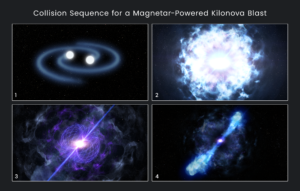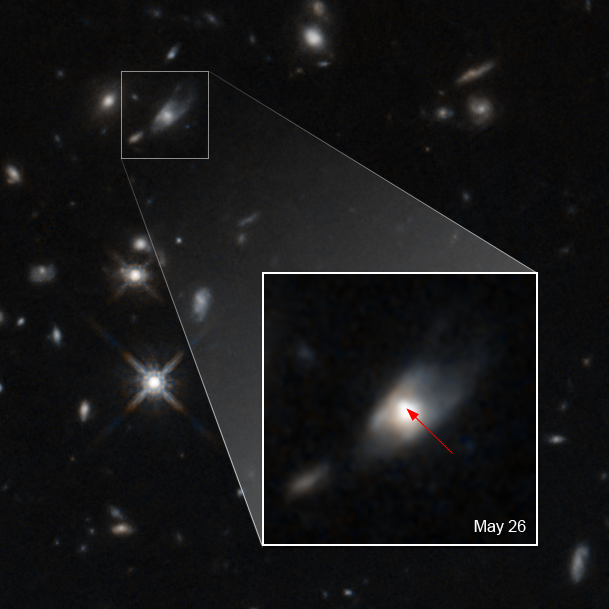Neutron-Star Collision Releases Puzzling Burst of Infrared Light
Long ago and far across the universe, an enormous burst of gamma rays unleashed more energy in a half-second than the Sun will produce over its entire 10-billion-year lifetime. In May of 2020, light from the flash finally reached Earth and was first detected by NASA’s Neil Gehrels Swift Observatory. Scientists quickly enlisted other telescopes — including NASA’s Hubble Space Telescope, the Very Large Array radio observatory, the W. M. Keck Observatory, and the Las Cumbres Observatory Global Telescope network — to study the explosion’s aftermath and the host galaxy. It was Hubble that provided the surprise.
Based on X-ray and radio observations from the other observatories, astronomers were baffled by what they saw with Hubble: the near-infrared emission was 10 times brighter than predicted. These results challenge conventional theories of what happens in the aftermath of a short gamma-ray burst. One possibility is that the observations might point to the birth of a massive, highly magnetized neutron star called a magnetar.

Collision Sequence for a Magnetar-Powered Kilonova Blast Illustration. Credit: NASA, ESA, and D. Player (STScI)
“These observations do not fit traditional explanations for short gamma-ray bursts,” said study leader Wen-fai Fong of Northwestern University in Evanston, Illinois. “Given what we know about the radio and X-rays from this blast, it just doesn’t match up. The near-infrared emission that we’re finding with Hubble is way too bright. In terms of trying to fit the puzzle pieces of this gamma-ray burst together, one puzzle piece is not fitting correctly.”
Without Hubble, the gamma-ray burst would have appeared like many others, and Fong and her team would not have known about the bizarre infrared behavior. “It’s amazing to me that after 10 years of studying the same type of phenomenon, we can discover unprecedented behavior like this,” said Fong. “It just reveals the diversity of explosions that the universe is capable of producing, which is very exciting.”
Continue to the full press release NASA/Hubble Space Telescope Science Institute.
PhD student Jillian Rastinejad is 3rd author of the study.
Learn More
- The Astrophysical Journal, “The Broad-band Counterpart of the Short GRB 200522A at z=0.5536: A Luminous Kilonova or a Collimated Outflow with a Reverse Shock?” by Fong, W. et al
- Northwestern News, “Birth of magnetar from colossal collision potentially spotted for first time” by Amanda Morris
- W.M. Keck Observatory, “Unexplained Brightness From Colossal Explosion“
- Center for Astrophysics | Harvard & Smithsonian, “Scientists Uncover Truth About Luminous Infrared Kilonova“
Media Mentions of CIERA/Northwestern
- MSN, “Birth of Magnetar Witnessed for the First Time After Massive Cosmic Explosion“
- CNET, “Explosive neutron star collision may have created a rare, extreme star” by Jackson Ryan
- Smithsonian, “In a First, Astronomers Witnessed the Birth of a Supermassive Magnetar Following a Glorious Kilonova” by Rasha Aridi
- Popular Science, “This ‘kilonova’ shines so bright, it defies the odds” by Jessica Boddy
- ScienceNews, “Astronomers spotted colliding neutron stars that may have formed a magnetar” by Lisa Grossman
- Cosmos Magazine, “Astronomers detect rare kilonova explosion” by Richard A. Lovett
- Digital Trends, “Dramatic luminous kilonova is 10 times brighter than predicted” by Georgina Torbet
- IFL Science, “Brightest Kilonova To Date Gives Insight Into The Origin Of Gamma-Ray Bursts” by Dr. Alfredo Carpineti
- Live Science, “Birth of magnetar seen for the first time” by Rafi Letzter
- Sky & Telescope, “GAMMA-RAY FLASH HERALDS BIRTH OF A MAGNETAR” by Monica Young
- Forbes, “NASA’s Hubble Spots ‘Bizarre Glow’ After An ‘Impossible’ Explosion In Space” by Jamie Carter
- Space.com, “Scientists spot a ‘kilonova’ flash so bright they can barely explain it” by Meghan Bartels
- New Atlas, “Neutron star collision sheds new light on short gamma ray bursts” by David Szondy
- Tech Times, “Hubble Finds Bright ‘Kilonova’ Scientists Can Barely Explain and a Cosmic Amethyst” by Nhx T.

This image shows the glow from a kilonova caused by the merger of two neutron stars. The kilonova, whose peak brightness reaches up to 10,000 times that of a classical nova, appears as a bright spot (indicated by the arrow) to the upper left of the host galaxy. The merger of the neutron stars is believed to have produced a magnetar, which has an extremely powerful magnetic field. The energy from that magnetar brightened the material ejected from the explosion. Image Credit: NASA, ESA, W. Fong (Northwestern University), and T. Laskar (University of Bath, UK)


